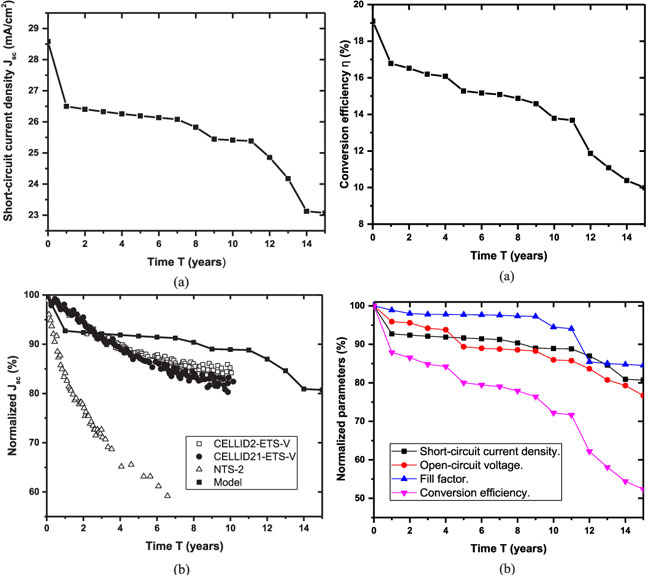Although gallium arsenide (GaAs) solar cells have been proved to be relatively stable under space working conditions, they are vulnerable to aging, resulting in poor characteristics. The life of solar cells is limited by the degree of radiation damage they are subjected to. This important factor affects the performance of solar cells in practical applications. This paper aims to study the effect of aging on the main characteristics of space GaAs solar cells by numerical simulation. The degradation of electrical characteristics has been simulated for more than 15 years. The atmospheric (AM0) conversion efficiency decreased from 19.08% of the unirradiated battery to 10.38% of the 15 year space mission. Even if low doses of particle radiation are used, the performance will be significantly reduced during the 15 years of space mission. The numerical simulation results also show that the short-circuit current, open circuit voltage and conversion efficiency gradually decrease with time. In addition, the evolution of the calculation is very consistent with the measurement behavior of GaAs solar cells embedded in geostationary satellites during navigation technology satellite 2 (nts-2), engineering test satellite V (ets-v) and navigation satellite. The timing and ranging (NAVSTAR) task confirms the introduced aging law, taking into account the cumulative dose of particles and different electron and hole traps in the structure.

Organic-inorganic hybrid perovskite has attracted great attention because of its potential application in the next generation space solar cells. Although the effects of particle irradiation on perovskite materials and devices have been studied, the correlation between the structural evolution of materials and the performance of devices under irradiation deserves further clarification. Here, through comprehensive experimental characterization and defect simulation, it is revealed that ch3nh3pbi3 (mapbi3) solar cell is irradiated by 50 keV proton (up to 1 × The relationship between structural damage and performance degradation of 1015 P cm-2). Mapbi3 thin film and solar cell pairs up to 1 × Proton irradiation at 1014 P cm-2 showed excellent tolerance. In contrast, because in 1 × At the higher proton fluence of 1015 P cm-2, the degradation of organic groups leads to partial amorphization, the photoluminescence spectrum of mapbi3 film is quenched, the carrier lifetime is shortened from 57.8 ns to 17.6 ns, and the number of density trap states is reduced from 8.32 × 1015 to 1.69 × 1016 cm–3.